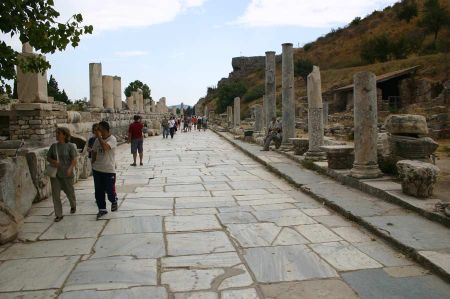Archaeologists discover a late antique barroom in Ephesus
- Written by Portal Editor
The former metropolis Ephesus was located in a valley between two mountain ridges, whose slopes today are still without firming forests because of the once densely constructions, so the ridges are still in motion.
Rain and washouts continually threatens the excavation work of archaeologists, what they're trying to prevent, for example, by the help of establishing of dry stone walls. Even today, archaeological undeveloped areas are vulnerable to landslides, which is why the researchers observe the ratios continuously. As part of this protection works to protect the archaeological sites, researchers of the Austrian Archaeological Institute (ÖAI) talk about "a sensation" since they discovered a barroom from the early 7th century, which allows a view to numerous ideas into the former everyday life.
Within the construction one of probably many similar "shops" at the former main road could be opened. The so-called "tavern" from the Byzantine period was discovered directly at the Kuretes Street - one of the main roads through Ephesus. That it was a late antique inn, the scientists conclude from more than a hundred completely preserved vessels - including cups, bowls and plates and many amphorae. In addition, they found a number of benches and small tables. Even a shelf was excavated on which dishes were still in place.
For the director and excavation manager of Ephesus, Sabine Ladstätter, "clarified discovering our ideas of the Kuretes Street as a lifeline and a communication center of the city in late antiquity. Public life and with it the economic and social bustle shifted from the big square systems towards the urban boulevards, which were designed both representative and infrastructural subsequently. "In the tavern local wines were served from different regions of origin as well as snacks. "In addition to the regional grape varieties on the walls we found amphorae from Gaza and Cilicia," said Sabine Ladstätter.
The extremely good state of preservation of the small pub the archaeologist explain with the immediate, even with the abrupt end of the host plant: The destruction was carried out suddenly in the early 7th century. The inventory of the pub at the time was just lying on the ground without someone subsequently attempted a reconstruction.
This is indicated by the numerous coins found in the studied archaeological layer. These was "particularly interesting, since it clearly demonstrates recognizable an earlier, dramatic cut in the monetary circulation of the city during the reign of Emperor Heraclius (610-641)," said Nikolaus Schindel, head of the working group Numismatics at the Institute for Studies of Ancient Culture of the Austrian Academy of Sciences.
Currently the ruler Heraclius raged a war with the Sassanian Iran. Ephesus could then also have been captured, the researchers suggested. "Especially the above mentioned average large number of serious coins in the tavern proves that the incident was so severe that not even easily searchable coins were not collected," said Schindel. The demolitions were certainly sustainable, just the main street Kuretes was reopened, presumably to ensure a good connection from the port to the Christian pilgrim shrines.
The excavations in Ephesus by the Austrian Archaeological Institute (ÖAI) held since 1895, every year around 250 scientists from 20 countries participate in the archaeological major project.
Please read as well:
